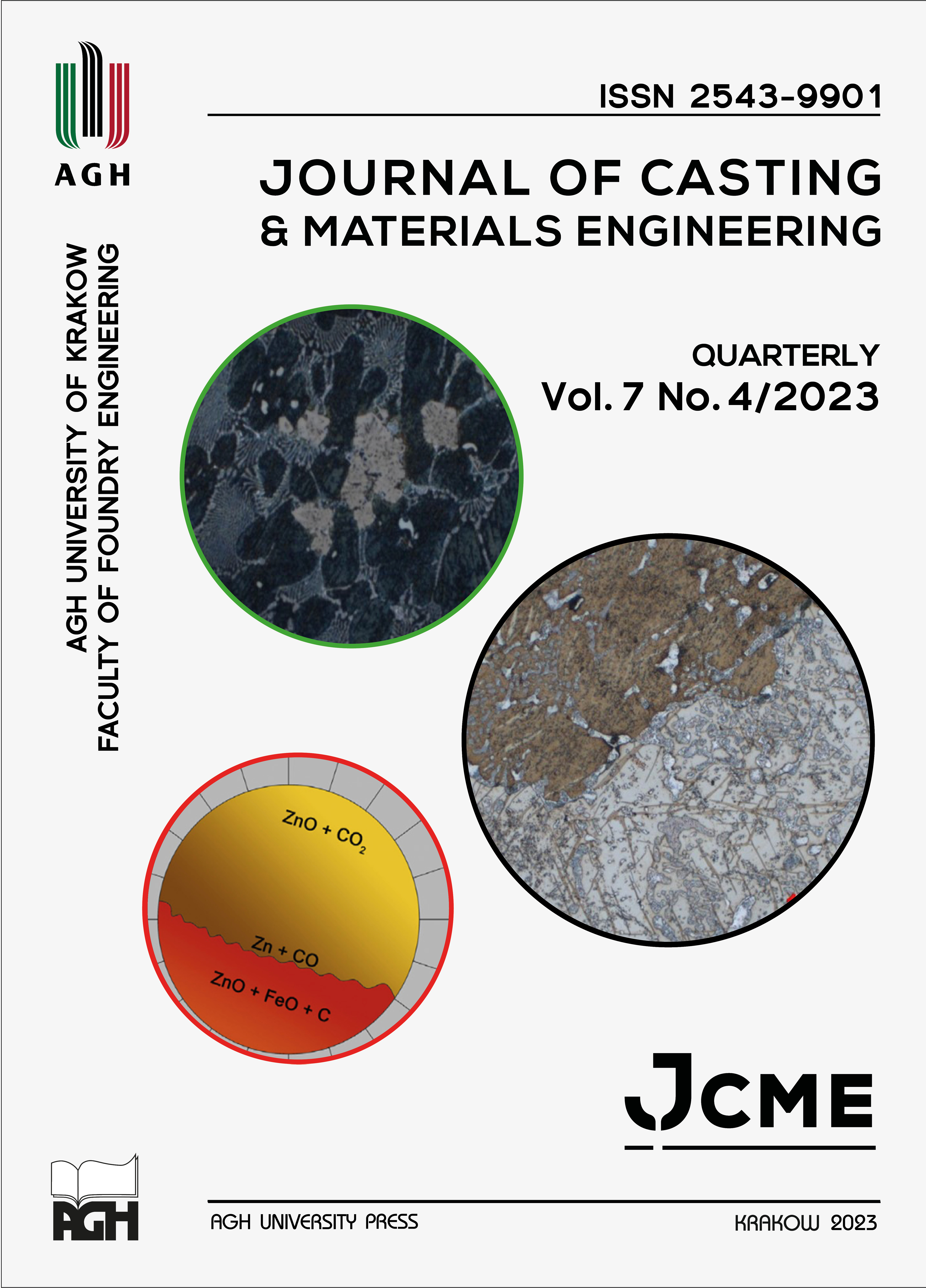Polylactide Used as Filment in 3d Printing – Part 2: TG-DTG, DSC and DRIFT investigations
DOI:
https://doi.org/10.7494/jcme.2023.7.4.41Abstract
A series of structural and thermal analysis research (TG-DTG, DSC, DRIFT) were performed for the samples of polylactide (PLA), which is commonly used in additive technologies as a structural material. In total four materials were considered, including two containing dyes with different colors, a material made of PLA recyclate and a graphene-modified PLA material. It was noted that PLA material reinforced with graphene phase (GRAFYLON®) retains the best thermal properties (TG-DTG), which results in wider possibilities of its processing, including further modification and usability in manufacturing vehicle structural elements. Recycled PLA material (ALFA+W) was characterized by a higher melting point (Tp) by more than 20oC than other samples (DSC analysis), so it can be more useful in the production of structural elements operating, as well as used at elevated temperatures.
Downloads
References
Siemiński P. & Budzik G. (2015). Techniki przyrostowe. Druk 3D. Drukarki 3D. Warszawa: Oficyna Wydawnicza Politechniki Warszawskiej.
Ślusarczyk P. (2017). Nowa “krzywa hype’u Gartnera” dla sektora druku 3D. Retrieved from https://centrumdruku3d.pl/nowa-krzywa-hypeu-gartnera-dla-sektora-druku-3d/ [accessed 7.11.2022].
Fontana L., Minetola P., Iuliano L., Rifuggiato S., Khandpur M.S. & Stiuso V. (2022). An investigation of the influence of 3D printing parameters on the tensile strength of PLA material. Materials Today: Proceedings, 57, 657–663. Doi: https://doi.org/
1016/j.matpr.2022.02.078.
Dodziuk H. (2019). Druk 3D/AM. Zastosowania oraz skutki społeczne i gospodarcze. Warszawa: Wydawnictwo Naukowe PWN.
Notta-Cuvier D., Odent J., Delille R., Murariu M., Lauro F., Raquez J.M., Bennani B. & Dubois P. (2014). Tailoring polylactide (PLA) properties for automotive applications: Effect of addition of designed additives on main mechanical properties. Polymer Testing, 36(36), 1–9. Doi: https://doi.org/10.1016/j.polymertesting.2014.03.007.
Jain R. & Gupta N. (2022). Design optimization of PLA lattice in 3D printing. Materials Today: Proceedings, 59, 1577–1583. Doi: https://doi.org/10.1016/j.matpr.2022.02.186.
Grabowska B., Kaczmarska K., Cukrowicz S., Mączka E. & Bobrowski A. (2020). Polylactide used as filment in 3D printing – Part 1: FTIR, DRIFT and TG-DTG studies. Journal of Casting & Materials Engineering, 4(3), 48–52. Doi: https://doi.org/10.7494/jcme.2020.4.3.48.
Przybytek A., Kucińska-Lipka J. & Janik H. (2016). Thermoplastic elastomer filaments and their application in 3D printing. Elastomery, 20(4), 32–39.
Rabek J.F. (2012). Polimery: otrzymywanie, metody badawcze, zastosowanie. Warszawa: Wydawnictwo Naukowe PWN.
Grabowska B. (2019). Polimery. Budowa. Otrzymywanie. Właściwości. Aplikacje w odlewnictwie. Kraków: Wydawnictwo Naukowe Akapit.
Królikowski W. (2012). Polimerowe kompozyty konstrukcyjne. Warszawa: Wydawnictwo Naukowe PWN.
Chanda M. & Roy S.K. (2019). Industrial Polymers, Specialty Polymers, and Their Applications. CRC PRESS.
Integracja druku 3D w przemyśle motoryzacyjnym. (n.d.). Retrieved from https://hp3d.pl/blog/integracja-druku-3d-w-przemysle-motoryzacyjnym/ [accessed 7.11.2022].
Szafrański B. (2017). Druk 3D w prototypowaniu i produkcji. Główny Mechanik, 5–6, 17–23.
Filament ABS i PLA dla drukarek 3D. (n.d.). Retrieved from http://www.plastspaw.pl/filament-drukarki-3d.html [accessed 7.11.2022].
PN-EN ISO 11358-1:2014-09: Tworzywa sztuczne – Termograwimetria (TG) polimerów – Część 1: Zasady ogólne. (2014). Retrieved from https://sklep.pkn.pl/pn-en-iso-11358-1-2014-09e.html.
PN-EN ISO 11357-1:2016-11: Tworzywa sztuczne – Różnicowa kalorymetria skaningowa (DSC) – Część 1: Zasady ogólne. (2016). Retrieved from https://sklep.pkn.pl/pn-en-iso-11357-1-2016-11e.html.
PN-EN ISO 11357-2:2020-09: Tworzywa sztuczne – Różnicowa kalorymetria skaningowa (DSC) – Część 2: Wyznaczanie temperatury zeszklenia i stopnia przejścia w stan szklisty. (2020). Retrieved from https://sklep.pkn.pl/pn-en-iso-11357-2-2020-09e.html.
PN-EN ISO 11357-3:2018-06: Tworzywa sztuczne – Różnicowa kalorymetria skaningowa (DSC) - Część 3: Oznaczanie temperatury oraz entalpii topnienia i krystalizacji. (2018). Retrieved from https://sklep.pkn.pl/pn-en-iso-11357-3-2018-06e.html.
Downloads
Published
Issue
Section
License
Copyright (c) 2023 Beata Grabowska, Mateusz Skowron, Karolina Kaczmarska

This work is licensed under a Creative Commons Attribution 4.0 International License.
How to Cite
Accepted 2023-09-21
Published 2023-10-23


